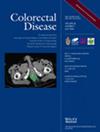Drain fluid iodine as a biomarker of anastomotic leak after low anterior resection in patients undergoing Gastrografin rectal tube flushes and omission of a diverting ileostomy: The GUSH study
Abstract
Aim
Anastomotic leak (AL) is the anathema of colorectal surgery and its occurrence constitutes a serious risk to patients and places a substantial burden on the health system. The analysis of extravasated intraluminal substances in drain fluid has shown promise for the early detection of AL. The aim of this study is to assess the measurement of drain fluid iodine as a biomarker of AL.
Method
This prospective, observational, 2b exploration cohort study measured the iodine in drain fluid of patients undergoing a low colorectal anastomosis and without a diverting ileostomy (DI) when the rectal tube was flushed with Gastrografin®. Iodine was measured by dual-energy computed tomography (DECT) and inductively coupled plasma mass spectroscopy (ICPMS).
Results
Sixty-six patients underwent a rectal resection and low colorectal anastomosis. Five patients experienced an AL. Four had grade C AL and returned to the operating theatre for peritoneal lavage and DI. The fifth was diagnosed at 30 days postoperatively and underwent image-guided drainage (grade B). The mean drain fluid iodine was significantly elevated in patients who experienced an AL compared with those who did not, as measured by DECT and ICPMS. The mean iodine value was 6.05 mg/mL vs. 0.088 mg/mL (p < 0.0001) for DECT and 41 437 μmol/L vs. 3.81 μmol/L (p < 0.0001) for ICPMS.
Conclusion
This study showed that drain iodine can be used as a sensitive indicator of early AL in patients undergoing a rectal resection with an extraperitoneal colorectal anastomosis and omission of a DI and when the rectal tube is flushed with Gastrografin following surgery.


 求助内容:
求助内容: 应助结果提醒方式:
应助结果提醒方式:


